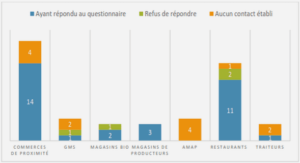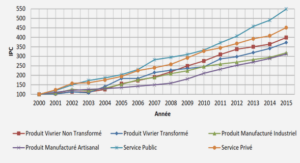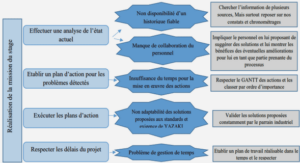Iron Intermetallic Phases in Al-7Si-Mg Alloys
Qualitative and Quantitative Analyses
The following subsections will cover a qualitative and quantitative analysis of the Kphase formed in non-modified and Sr-modified Al-7Si-Mg alloys in terms of the various metallurgical parameters affecting its formation in said alloys.
Effects of Iron and Magnesium Content
Figure 4.6 illustrates the effects of Fe and Mg content on the volume fraction of the 7r-phase in non-modified and Sr-modified Al-7Si-xMg-yFe alloy samples obtained from graphite mold castings, (SDAS ~ 65 um), in the as-cast and solution heat-treated conditions.As the Fe content increases from 0.1 wt% to 0.8 wt%, the jr-phase volume fraction increases by varying degrees in the non-modified and Sr-modified alloys at all levels of Mg content, as can be seen in Figures 4.6(a) and (b), respectively. Figure 4.6(b) demonstrates how the addition of 0.02 wt% Sr to Al-7Si-xMg-yFe alloys results in slight increases in the volume fraction of the jr-phase, compared to Figure 4.6 (a). This may be explained in terms of the presence of Sr which results in breaking up /?-phase platelets as reported by Samuel et al.,70 thereby reducing the length and increasing the density of /?-phase platelets. The authors claim that Sr was absorbed by the /?-phase platelets leading to their destabilization, and hence, to their fragmentation. This may contribute to an increase in the number of /?- platelets available for the peritectic reaction to occur thereby forming further amounts of zphase.
Figure 4.6 also demonstrates the effects of solution heat treatment at 540°C/8hr on the jr-phase volume fraction in non-modified and Sr-modified Al-7Si-xMg-yFe alloys. In non-modified Al-7Si-0.4Mg-yFe alloys, as shown in Figure 4.6(a), the jr-phase is almost completely dissolved at all Fe levels after solution heat treatment. The non-modified Al7Si-0.4Mg-0.1Fe alloy microstructures shown in Figures 4.7(a) and (b) support this observation. Figure 4.7(a) shows the 7r-phase in the as-cast condition, while Figure 4.7 (b) reveals the presence of fine needles in the microstructure after solution heat treatment. The X-ray images of the Mg and Fe distribution within these fine needles are presented in Figures 4.7(c) and (d), respectively, and support the claim that the fine needles are indeed /?-phase needles. This observation suggests that, during solution heat treatment, the 7r-phase in the 356 alloy having 0.4 wt% Mg is completely dissolved and decomposed into fine /?- phase needles as a result of the presence of Mg which diffuses out from the ?r-phase and into the surrounding aluminum matrix. This observation confirms the findings of Taylor et al.10 who reported that, at 0.3-0.4 wt% Mg, the as-cast Chinese-script in 356 alloys ;r-phase is reduced as a result of its transformation into clusters of fine/?-phase needles.
On the other hand, in the solution heat-treated Sr-modified Al-7Si-0.4Mg-yFe alloys, the 7r-phase is not completely decomposed after solution heat treatment, may be seen from Figure 4.6 (b). This observation is supported by the microstructures of the solution heat-treated Sr-modified Al-7Si-0.4Mg-0.1Fe alloy in Figures 4.8(a) and (b), where Figure 4.8(a) shows the as-cast microstructure and Figure 4.8(b) reveals fine needles accompanied by small spheroidized 7r-phase particles. These spheroidized particles are expected to reveal the process of decomposition of the u-phase into /?-phase needles. The X-ray images corresponding to the backscattered image of Figure 4.8(b), and showing the distribution of Fe and Mg in the decomposed 7r-phase, namely Figures 4.8(c) and 4.8(d), confirm this observation. Based on the latter, it may be suggested that the incomplete decomposition of the 7r-phase into /?-phase needles in solution heat-treated Sr-modified Al-7Si-0.4Mg-0.1Fe alloys is most likely related to the existence of moderately large 7r-phase particles for which a longer solution heat treatment time of more than 8 hours may be required to achieve complete decomposition of the 7i-phase. It will also be observed from Figures 4.6(a) and 4.6(b) that when the Mg content in Al-7Si-xMg-yFe alloys is higher than 0.4 wt%, there is an increase in the resistance of the ?r-phase to decompose completely into /?-phase needles after 8hr of solution heat treatment in both the non-modified and Srmodified alloys compared to 0.4 wt% Mg alloys. This observation is supported by the microstructures of the solution heat-treated non-modified Al-7Si-0.75Mg-0.1Fe alloy, as shown in Figure 4.9. Figure 4.9(a) corresponds to the as-cast microstructure; Figure 4.9(b) shows a small amount of the 7r-phase particles decomposed into fine/?-phase needles, while the remaining particles display fragmentation and spheroidization. The chemical composition of the ?r-phase as obtained by WDS analysis of the as-cast and solution heattreated samples in the Al-7Si-0.8Mg-0.1Fe alloy, as listed in Table 4.3, reveals that there is almost no change in the composition of ?r-phase in both conditions. It will be seen that the calculated stoichiometry of the 7r-phase in both conditions approaches the suggested formula of Al8FeMg3Si6.
Deconchat et Baient (2001) ainsi que les études de Roberts et Zhu (2002) ont montré la relation entre les travaux de récolte ligneuse et une augmentation du nombre d’espèces sur une courte période de temps. Cette réponse du système serait symptomatique de la création des nouveaux microsites et de la colonisation potentielle du milieu.
Cependant, cette courte augmentation de la richesse spécifique (S) n’est pas observée dans les milieux denses. En accord avec Deconchat et Baient (2001), la colonisation de nouvelles espèces est également liée au moyen de transport des graines, à la limite de distribution des espèces et à l’hétérogénéité de milieux adjacents. En accord avec les travaux de Roberts et Zhu (2002) réalisés dans les forêts mixtes du Nouveau- Brunswick, l’augmentation rapide de la richesse spécifique est suivie d’une diminution graduelle du nombre d’espèces et ce, jusqu’au niveau d’avant perturbation. Des espèces telles YAlnus rugosa (Du Roi) Spreng., la Linnaea borealis L. et le Sorbus americana Marsh, ont colonisé temporairement les parterres de coupe des DS. Cette variation de la composition floristique après perturbation peut expliquer la différence observée dans l’assemblage d’espèces. Les analyses multidimensionnelles suggèrent un retour à la composition végétale d’origine des DS plus rapide et ce, même après une variation floristique plus marquée entre les années. Par ailleurs, la diminution progressive de S après la première et la deuxième année suivant les traitements sylvicoles dans les milieux ouverts, pourrait hypothétiquement s’expliquer par la faible productivité, Pallélopathie et d’autres facteurs négatifs liés à l’abondance d’éricacées et des lichens sur les parterres forestiers (Yamasaki et al. 2002; Mallik 2003). Ces facteurs inhiberaient ou nuirait à l’installation permanente des nouvelles espèces dans les peuplements ouverts.
|
Table des matières
ABSTRACT
LIST OF FIGURES
LIST OF TABLES
CHAPTER 1 INTRODUCTION
1.1 Defining the Problem
1.2 Objectives
CHAPTER 2 REVIEW OF THE LITERATURE
2.1 Introduction
2.2 Iron Intermetallic Phases in Al-7Si-Mg Alloys
2.2.1 Formation of Iron Intermetallics in Al-Si-Mg Alloys
2.2.2 Composition and Morphology of/? and jrlron Intermetallic Phases
2.3 Factors Affecting the Formation of Iron Intermetallic Phases
2.3.1 Effects of Iron Content
2.3.2 Effects of Magnesium Content
2.3.3 Cooling Rate
2.4 Mechanical Properties of Al-7Si-Mg Alloys
2.4.1 Effects of Size of Iron Intermetallic Phases
2.4.2 Effects of Alloying Elements and Impurities
2.4.2.1 Fe Content
2.4.2.2 Magnesium Content
2.4.2.3 Silicon Content
2.4.3 Modification
2.4.4 Cooling Rate
2.4.5 Heat Treatment
2.4.6 Trace Elements
CHAPTER 3 EXPERIMENTAL PROCEDURES
3.1 Introduction
3.2 Melt Preparation
3.3 Casting Procedures
3.3.1 Thermal Analysis and Related Studies
3.3.2 Solidification Rate and Related Studies
3.3.3 Mechanical Properties and Related Studies
3.3.3.1 Preparation of Bars for Tensile Testing
3.3.3.2 Preparation of Bars for Impact Testing
3.4 Heat Treatment
3.5 Mechanical Testing
3.5.1 Tensile Testing
3.5.2 Impact Testing
3.6 Examination of the Microstructure
3.6.1 Preparation of Samples
3.6.2 Qualitative and Quantitative Analyses
3.6.2.1 SDAS Measurements
3.6.2.2 Eutectic Silicon Particle Measurements
3.6.2.3 Iron Intermetallic Phases
3.6.2.4 Fractography
CHAPTER 4 MICROSTRUCTURAL ANALYSIS
4.1 Introduction
4.2 Microstructure Features and Phase Identification
4.3 Thermal Analysis
4.3.1 Effects of Iron and Magnesium Content
4.3.2 Effects of Beryllium Addition
4.4 Qualitative and Quantitative Analyses
4.4.1 Effects of Iron and Magnesium Content
4.4.2 Effects of Beryllium Addition
4.4.3 Effects of Solution Heat Treatment Time
4.4.4 Effects of Cooling Rate
4.5 Impact of n- to/?-Phase Decomposition on Matrix Chemistry
4.6 Mechanism of 7r-to/?-Phase Decomposition
4.7 Conclusions
CHAPTER 5 MECHANICAL PROPERTIES
5.1 Introduction
5.2 Silicon Particle Characterization
5.3 Impact Test Results
5.4 Fractography
5.4.1 SEM Analysis of Fracture Surfaces
5.4.2 Microstructural Analysis of Fracture Profile
5.5 Tensile Test Results
5.6 Conclusions
RECOMMENDATIONS FOR FUTURE WORK
REFERENCES
![]() Télécharger le rapport complet
Télécharger le rapport complet




